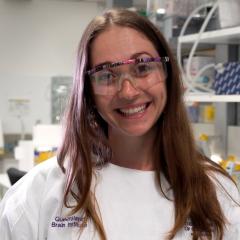The Eyles laboratory focuses on how early epidemiologically-validated risk factors for schizophrenia and autism, change the way the brain develops and functions with a particular focus on dopamine systems. We also want to understand how the adolescent brain progresses towards a hyperdopaminergic state.
Lab History
- In 2010 we established that low maternal levels of vitamin D was a risk factor for schizophrenia and autism in newborn dried blood spots using an assay developed by the group. This has initiated 15 international collaborations funded by 2 NIH grants and 3 NHMRC grants.
- Via our collaboration in Zurich we have now shown vitamin D is capable of blocking all symptom phenotypes in a maternal immune activation model of schizophrenia. (funded by 2 NHMRC grants).
- Our latest studies show that maternal vitamin D deficiency, maternal immune activation and prenatal hypoxia (well validated risk factors for schizophrenia) all affect the early differentiation, positioning and connectivity of dopamine neurons. This exciting discovery may mean that the cause of schizophrenia (where there is abnormal dopamine signalling) may be due to very early alterations in the ontogeny of these neurons. We are now focused on the exact convergent mechanisms. (funded by multiple NHMRC grants).
- We have recently shown the molecular processes behind how maternal vitamin D deficiency increases testosterone in developing brains. This work may have broader implications for why autism is more common in boys. (funded by 1 NHMRC grant)
- Sub-cortical dopamine systems are pre-symptomatically hyperactive in schizophrenia selectively in a circuit known as the dorsal striatum. Using a novel genetic construct used to treat Parkinson’s disease (Lund University) we have now developed a model of this important aspect of the schizophrenia prodrome. In collaboration with the clinical group who first showed that dopamine abnormalities were presymptomatic in patients at King’s College London we have now been able to completely replicate this circuit abnormality progressively across late adolescence in an animal model. We are now using this model to understand:
- how interconnected circuits become dysfunctional in schizophrenia,
- how this may produce hyperinflammatory conditions in the midbrain
- how such circuits interact with stress and psychoactive compounds
- To trial potential prophylactic agents to block/retard the onset of schizophrenia. (funded by 1 NHMRC grant)
Group leader

Professor Darryl Eyles
Conjoint Professor, Queensland Brain Institute
+61 7 334 66370
d.eyles@uq.edu.au
UQ Researcher Profile
Vitamin D in autism; preventative mechanisms
(2020–2021) Child Development Grant
Histology and Advanced Microscopy Research Facility upgrade
(2019) UQ Major Equipment and Infrastructure
(2018–2022) NHMRC Project Grant
(2018–2021) Murdoch Childrens Research Institute
(2018–2022) NHMRC Project Grant
(2017–2022) NHMRC Project Grant
Developmental Neurobiology of Vitamin D Deficiency Program Funding
(2012–2022) West Moreton Hospital and Health Service
Tamang, Man Kumar, Ali, Asad, Pertile, Renata Nedel, Cui, Xiaoying, Alexander, Suzy, Nitert, Marloes Dekker, Palmieri, Chiara and Eyles, Darryl (2023). Developmental vitamin D-deficiency produces autism-relevant behaviours and gut-health associated alterations in a rat model. Translational Psychiatry, 13 (1) 204. doi: 10.1038/s41398-023-02513-3
Vitamin D: A potent regulator of dopaminergic neuron differentiation and function
Pertile, Renata Aparecida Nedel, Brigden, Rachel, Raman, Vanshika, Cui, Xiaoying, Du, Zilong and Eyles, Darryl (2023). Vitamin D: A potent regulator of dopaminergic neuron differentiation and function. Journal of Neurochemistry, 166 (5), 779-789. doi: 10.1111/jnc.15829
Animal models of relevance to the schizophrenia prodrome
Petty, Alice, Howes, Oliver and Eyles, Darryl (2023). Animal models of relevance to the schizophrenia prodrome. Biological Psychiatry Global Open Science, 3 (1), 22-32. doi: 10.1016/j.bpsgos.2021.12.001
Vitamin D and the central nervous system: causative and preventative mechanisms in brain disorders
Cui, Xiaoying and Eyles, Darryl W. (2022). Vitamin D and the central nervous system: causative and preventative mechanisms in brain disorders. Nutrients, 14 (20) 4353, 1-20. doi: 10.3390/nu14204353
Berger, Kimberly, Poon, Victor, Kharrazi, Marty, Eyles, Darryl, Lyall, Kristen, Volk, Heather E., Croen, Lisa A., Windham, Gayle and Pearl, Michelle (2022). Mixture analysis of air pollution and endocrine disrupting chemicals in relation to Vitamin D concentrations in pregnancy. ISEE Conference Abstracts, 2022 (1). doi: 10.1289/isee.2022.o-op-271
Aparecida Nedel Pertile, Renata, Kiltschewskij, Dylan, Geaghan, Michael, Barnett, Michelle, Cui, Xiaoying, Cairns, Murray J. and Eyles, Darryl (2022). Developmental vitamin D-deficiency increases the expression of microRNAs involved in dopamine neuron development. Brain Research, 1789 147953, 147953. doi: 10.1016/j.brainres.2022.147953
Prenatal hypoxia alters the early ontogeny of dopamine neurons
Brandon, Anastasia, Cui, Xiaoying, Luan, Wei, Ali, Asad Amanat, Pertile, Renata Aparecida Nedel, Alexander, Suzanne Adele and Eyles, Darryl Walter (2022). Prenatal hypoxia alters the early ontogeny of dopamine neurons. Translational Psychiatry, 12 (1) 238, 238. doi: 10.1038/s41398-022-02005-w
Does the gut microbiome mediate antipsychotic-induced metabolic side effects in schizophrenia?
Vasileva, Svetlina S., Tucker, Jack, Siskind, Dan and Eyles, Darryl (2022). Does the gut microbiome mediate antipsychotic-induced metabolic side effects in schizophrenia?. Expert Opinion on Drug Safety, 21 (5), 1-15. doi: 10.1080/14740338.2022.2042251
Animal models of relevance to the schizophrenia prodrome
Petty, Alice, Howes, Oliver and Eyles, Darryl (2021). Animal models of relevance to the schizophrenia prodrome. Biological Psychiatry Global Open Science. doi: 10.1016/j.bpsgos.2021.12.001
Hussain, Sultana Monira, Wang, Yuanyuan, Heath, Alicia K., Giles, Graham G., English, Dallas R., Eyles, Darryl W., Williamson, Elizabeth J., Graves, Stephen E., Wluka, Anita E. and Cicuttini, Flavia M. (2021). Association between circulating 25-hydroxyvitamin D concentrations and hip replacement for osteoarthritis: a prospective cohort study. BMC Musculoskeletal Disorders, 22 (1) 887, 887. doi: 10.1186/s12891-021-04779-4
Developmental vitamin D deficiency in pregnant rats does not induce preeclampsia
Ali, Asad, Alexander, Suzanne, Ko, Pauline, Cuffe, James S. M., Whitehouse, Andrew J. O., McGrath, John J. and Eyles, Darryl (2021). Developmental vitamin D deficiency in pregnant rats does not induce preeclampsia. Nutrients, 13 (12) 4254. doi: 10.3390/nu13124254
Cui, Xiaoying, Pertile, Renata Ap. Nedel, Du, Zilong, Wei, Wei, Sun, Zichun, Eyles, Darryl W. and Kesby, James P. (2021). Developmental inhibition of long intergenic non-coding RNA, HOTAIRM1, impairs dopamine neuron differentiation and maturation. International Journal of Molecular Sciences, 22 (14) 7268, 7268. doi: 10.3390/ijms22147268
How do established developmental risk-factors for schizophrenia change the way the brain develops?
Eyles, Darryl W. (2021). How do established developmental risk-factors for schizophrenia change the way the brain develops?. Translational Psychiatry, 11 (1) 158, 158. doi: 10.1038/s41398-021-01273-2
Liang, Yujie, Yu, Hong, Ke, Xiaoyin, Eyles, Darryl, Sun, Ruoyu, Wang, Zichen, Huang, Saijun, Lin, Ling, McGrath, John J., Lu, Jianping, Guo, Xiaoling and Yao, Paul (2021). Vitamin D deficiency worsens maternal diabetes induced neurodevelopmental disorder by potentiating hyperglycemia-mediated epigenetic changes. Annals of the New York Academy of Sciences, 1491 (1), 74-88. doi: 10.1111/nyas.14535
Petty, Alice, Cui, Xiaoying, Ali, Asad, Du, Zilong, Srivastav, Sunil, Kesby, James P., Kirik, Deniz, Howes, Oliver and Eyles, Darryl (2021). Positive symptom phenotypes appear progressively in “EDiPS”, a new animal model of the schizophrenia prodrome. Scientific Reports, 11 (1) 4294, 4294. doi: 10.1038/s41598-021-83681-4
Vitamin D and schizophrenia: 20 years on
Cui, Xiaoying, McGrath, John J., Burne, Thomas H. J. and Eyles, Darryl W. (2021). Vitamin D and schizophrenia: 20 years on. Molecular Psychiatry, 26 (7), 2708-2720. doi: 10.1038/s41380-021-01025-0
Developmental vitamin D deficiency increases foetal exposure to testosterone
Ali, Asad Amanat, Cui, Xiaoying, Pertile, Renata Aparecida Nedel, Li, Xiang, Medley, Gregory, Alexander, Suzanne Adele, Whitehouse, Andrew J. O., McGrath, John J. and Eyles, Darryl Walter (2020). Developmental vitamin D deficiency increases foetal exposure to testosterone. Molecular Autisum, 11 (1) 96, 96. doi: 10.1186/s13229-020-00399-2
Windham, Gayle C., Pearl, Michelle, Poon, Victor, Berger, Kimberly, Soriano, Jasmine W., Eyles, Darryl, Lyall, Kristen, Kharrazi, Martin and Croen, Lisa A. (2020). Maternal Vitamin D Levels During Pregnancy in Association With Autism Spectrum Disorders (ASD) or Intellectual Disability (ID) in Offspring; Exploring Non-linear Patterns and Demographic Sub-groups. Autism Research, 13 (12), 2216-2229. doi: 10.1002/aur.2424
Genome-wide association study identifies 143 loci associated with 25 hydroxyvitamin D concentration
Revez, Joana A., Lin, Tian, Qiao, Zhen, Xue, Angli, Holtz, Yan, Zhu, Zhihong, Zeng, Jian, Wang, Huanwei, Sidorenko, Julia, Kemper, Kathryn E., Vinkhuyzen, Anna A. E., Frater, Julanne, Eyles, Darryl, Burne, Thomas H. J., Mitchell, Brittany, Martin, Nicholas G., Zhu, Gu, Visscher, Peter M., Yang, Jian, Wray, Naomi R. and McGrath, John J. (2020). Genome-wide association study identifies 143 loci associated with 25 hydroxyvitamin D concentration. Nature Communications, 11 (1) 1647, 1-12. doi: 10.1038/s41467-020-15421-7
Heath, Alicia K., Hodge, Allison M., Ebeling, Peter R., Kvaskoff, David, Eyles, Darryl W., Giles, Graham G., English, Dallas R. and Williamson, Elizabeth J. (2020). Circulating 25-hydroxyvitamin D concentration and cause-specific mortality in the Melbourne Collaborative Cohort Study. Journal of Steroid Biochemistry and Molecular Biology, 198 105612, 105612. doi: 10.1016/j.jsbmb.2020.105612
Genetic contributions to maternal and neonatal vitamin D levels
Traglia, Michela, Windham, Gayle C., Pearl, Michelle, Poon, Victor, Eyles, Darryl, Jones, Karen L., Lyall, Kristen, Kharrazi, Martin, Croen, Lisa A. and Weiss, Lauren A. (2020). Genetic contributions to maternal and neonatal vitamin D levels. Genetics, 214 (4), 1091-1102. doi: 10.1534/genetics.119.302792
Petty, Alice, Cui, Xiaoying, Tesiram, Yasvir, Kirik, Deniz, Howes, Oliver and Eyles, Darryl (2019). Enhanced dopamine in prodromal schizophrenia (EDiPS): a new animal model of relevance to schizophrenia. NPJ Schizophrenia, 5 (1) 6, 6. doi: 10.1038/s41537-019-0074-z
Gooch, Helen, Cui, Xiaoying, Anggono, Victor, Trzaskowski, Maciej, Tan, Men Chee, Eyles, Darryl W., Burne, Thomas H. J., Jang, Se Eun, Mattheisen, Manuel, Hougaard, David M., Pedersen, Bent Nørgaard, Cohen, Arieh, Mortensen, Preben B., Sah, Pankaj and McGrath, John J. (2019). 1,25-Dihydroxyvitamin D modulates L-type voltage-gated calcium channels in a subset of neurons in the developing mouse prefrontal cortex. Translational Psychiatry, 9 (1) 281, 281. doi: 10.1038/s41398-019-0626-z
Overeem, Kathie, Alexander, Suzy, Burne, Thomas H J, Ko, Pauline and Eyles, Darryl W (2019). Developmental vitamin D deficiency in the rat impairs recognition memory, but has no effect on social approach or hedonia. Nutrients, 11 (11) 2713, 2713. doi: 10.3390/nu11112713
Developmental vitamin D and autism spectrum disorders: findings from the Stockholm Youth Cohort
Lee, Brian K., Eyles, Darryl W., Magnusson, Cecilia, Newschaffer, Craig J., McGrath, John J., Kvaskoff, David, Ko, Pauline, Dalman, Christina, Karlsson, Håkan and Gardner, Renee M. (2019). Developmental vitamin D and autism spectrum disorders: findings from the Stockholm Youth Cohort. Molecular Psychiatry, 26 (5), 1578-1588. doi: 10.1038/s41380-019-0578-y
Schmidt, Rebecca J., Niu, Qiaojuan, Eyles, Darryl W., Hansen, Robin L. and Iosif, Ana-Maria (2019). Neonatal vitamin D status in relation to autism spectrum disorder and developmental delay in the CHARGE case–control study. Autism Research, 12 (6), 976-988. doi: 10.1002/aur.2118
Windham, Gayle C., Pearl, Michelle, Anderson, Meredith C., Poon, Victor, Eyles, Darryl, Jones, Karen L., Lyall, Kristen, Kharrazi, Martin and Croen, Lisa A. (2019). Newborn vitamin D levels in relation to autism spectrum disorders and intellectual disability: a case–control study in California. Autism Research, 12 (6), 989-998. doi: 10.1002/aur.2092
Ali, Asad, Vasileva, Svetlina, Langguth, Mia, Alexander, Suzanne, Cui, Xiaoying, Whitehouse, Andrew, McGrath, John J. and Eyles, Darryl (2019). Developmental vitamin D deficiency produces behavioral phenotypes of relevance to Autism in an animal model. Nutrients, 11 (5) 1187, 1187. doi: 10.3390/nu11051187
Heath, Alicia K., Hodge, Allison M., Ebeling, Peter R., Eyles, Darryl W., Kvaskoff, David, Buchanan, Daniel D., Giles, Graham G., Williamson, Elizabeth J. and English, Dallas R. (2019). Circulating 25-hydroxyvitamin D concentration and risk of breast, prostate, and colorectal cancers: the Melbourne Collaborative Cohort Study. Cancer Epidemiology, Biomarkers and Prevention, 28 (5), 900-908. doi: 10.1158/1055-9965.EPI-18-1155
Travis, Ruth C., Perez-Cornago, Aurora, Appleby, Paul N., Albanes, Demetrius, Joshu, Corinne E., Lutsey, Pamela L., Mondul, Alison M., Platz, Elizabeth A., Weinstein, Stephanie J., Layne, Tracy M., Helzlsouer, Kathy J., Visvanathan, Kala, Palli, Domenico, Peeters, Petra H., Bueno-de-Mesquita, Bas, Trichopoulou, Antonia, Gunter, Marc J., Tsilidis, Konstantinos K., Sanchez, Maria-Jose, Olsen, Anja, Brenner, Hermann, Schottker, Ben, Perna, Laura, Holleczek, Bernd, Knekt, Paul, Rissanen, Harri, Yeap, Bu B., Flicker, Leon, Almeida, Osvaldo P. ... Allen, Naomi E. (2019). A collaborative analysis of individual participant data from 19 prospective studies assesses circulating Vitamin D and prostate cancer risk. Cancer Research, 79 (1), 274-285. doi: 10.1158/0008-5472.CAN-18-2318
Mitchell, Brittany L., Zhu, Gu, Medland, Sarah E., Renteria, Miguel. E., Eyles, Darryl W., Grasby, Katrina L., McGrath, John J. and Martin, Nicholas G. (2019). Half the genetic variance in vitamin D concentration is shared with skin colour and sun exposure genes. Behavior Genetics, 49 (4), 386-398. doi: 10.1007/s10519-019-09954-x
The association between neonatal vitamin D status and risk of schizophrenia
Eyles, Darryl W., Trzaskowski, Maciej, Vinkhuyzen, Anna A. E., Mattheisen, Manuel, Meier, Sandra, Gooch, Helen, Anggono, Victor, Cui, Xiaoying, Tan, Men Chee, Burne, Thomas H. J., Jang, Se Eun, Kvaskoff, David, Hougaard, David M., Nørgaard-Pedersen, Bent, Cohen, Arieh, Agerbo, Esben, Pedersen, Carsten B., Børglum, Anders D., Mors, Ole, Sah, Pankaj, Wray, Naomi R., Mortensen, Preben B. and McGrath, John J. (2018). The association between neonatal vitamin D status and risk of schizophrenia. Scientific Reports, 8 (1) 17692, 17692. doi: 10.1038/s41598-018-35418-z
Functional and molecular changes in the nucleus accumbens of MK-801-sensitized rats
Lefevre, Emilia, Gooch, Helen, Josh, Peter, Alexander, Suzy, Eyles, Darryl W. and Burne, Thomas H. J. (2018). Functional and molecular changes in the nucleus accumbens of MK-801-sensitized rats. Behavioural Pharmacology, 30 (5), 1-395. doi: 10.1097/FBP.0000000000000447
Vitamin D regulation of GDNF/Ret signaling in dopaminergic neurons
Pertile, Renata A. N., Cui, Xiaoying, Hammond, Luke and Eyles, Darryl W. (2018). Vitamin D regulation of GDNF/Ret signaling in dopaminergic neurons. The FASEB Journal, 32 (2), fj201700713R-828. doi: 10.1096/fj.201700713R
Increasing paternal age alters anxiety-related behaviour in adult mice
Foldi, Claire J., Eyles, Darryl W., McGrath, John J. and Burne, Thomas H. J. (2018). Increasing paternal age alters anxiety-related behaviour in adult mice. Genes, Brain and Behavior, 18 (2) e12522, e12522. doi: 10.1111/gbb.12522
Miliku, Kozeta, Felix, Janine F., Voortman, Trudy, Tiemeier, Henning, Eyles, Darryl W., Burne, Thomas H., McGrath, John J. and Jaddoe, Vincent W. V. (2018). Associations of maternal and fetal vitamin D status with childhood body composition and cardiovascular risk factors. Maternal and Child Nutrition, 15 (2) e12672, e12672. doi: 10.1111/mcn.12672
Luan, Wei, Hammond, Luke Alexander, Vuillermot, Stephanie, Meyer, Urs and Eyles, Darryl Walter (2018). Maternal vitamin D prevents abnormal dopaminergic development and function in a mouse model of prenatal immune activation. Scientific Reports, 8 (1) 9741, 9741. doi: 10.1038/s41598-018-28090-w
Vitamin D status and the risk of type 2 diabetes: the Melbourne Collaborative Cohort Study
Heath, Alicia K., Williamson, Elizabeth J., Hodge, Allison M., Ebeling, Peter R., Eyles, Darryl W., Kvaskoff, David, O'Dea, Kerin, Giles, Graham G. and English, Dallas R. (2018). Vitamin D status and the risk of type 2 diabetes: the Melbourne Collaborative Cohort Study. Diabetes Research and Clinical Practice, 149, 179-187. doi: 10.1016/j.diabres.2018.05.007
Ali, Asad, Cui, Xiaoying, Alexander, Suzanne and Eyles, Darryl (2018). The placental immune response is dysregulated developmentally vitamin D deficient rats: Relevance to autism. The Journal of Steroid Biochemistry and Molecular Biology, 180, 73-80. doi: 10.1016/j.jsbmb.2018.01.015
Dopamine, psychosis and schizophrenia: the widening gap between basic and clinical neuroscience
Kesby, J. P., Eyles, D. W., McGrath, J. J. and Scott, J. G. (2018). Dopamine, psychosis and schizophrenia: the widening gap between basic and clinical neuroscience. Translational Psychiatry, 8 (1) 30, 1-12. doi: 10.1038/s41398-017-0071-9
Borg, Stephanie A., Buckley, Harriet, Owen, Robert, Marin, Ana Campos, Lu, Yongtau, Eyles, Darryl, Lacroix, Damien, Reilly, Gwendolen C., Skerry, Tim M. and Bishop, Nick J. (2018). Early life Vitamin D depletion alters the postnatal response to skeletal loading in growing and mature bone. PLoS One, 13 (1) e0190675, e0190675. doi: 10.1371/journal.pone.0190675
Cui, Xiaoying, Pertile, Renata and Eyles, Darryl W. (2017). The vitamin D receptor (VDR) binds to the nuclear matrix via its hinge domain: a potential mechanism for the reduction in VDR mediated transcription in mitotic cells. Molecular and Cellular Endocrinology, 472, 18-25. doi: 10.1016/j.mce.2017.11.015
Suetani, Shuichi, Saha, Sukanta, Eyles, Darryl W., Scott, James G. and McGrath, John J. (2017). Prevalence and correlates of suboptimal vitamin D status in people living with psychotic disorders: data from the Australian Survey of High Impact Psychosis. Australian and New Zealand Journal of Psychiatry, 51 (9), 921-929. doi: 10.1177/0004867416681853
Kesby, James P., Turner, Karly M., Alexander, Suzanne, Eyles, Darryl W., McGrath, John J. and Burne, Thomas H.J. (2017). Developmental vitamin D deficiency alters multiple neurotransmitter systems in the neonatal rat brain. International Journal of Developmental Neuroscience, 62 (C), 1-7. doi: 10.1016/j.ijdevneu.2017.07.002
Moe, Aung Aung Kywe, Medely, Gregory A., Reeks, Timothy, Burne, Thomas H. J. and Eyles, Darryl W. (2017). Short- and long-term effects of risperidone on catalepsy sensitisation and acquisition of conditioned avoidance response: adolescent vs adult rats. Pharmacological Research, 121, 1-13. doi: 10.1016/j.phrs.2017.04.013
Vitamin D and the brain: genomic and non-genomic actions
Cui, Xiaoying, Gooch, Helen, Petty, Alice, McGrath, John J. and Eyles, Darryl (2017). Vitamin D and the brain: genomic and non-genomic actions. Molecular and Cellular Endocrinology, 453 (C), 131-143. doi: 10.1016/j.mce.2017.05.035
Effect of the glucocorticoid receptor antagonist RU486 on MK-801 induced behavioural sensitization
Lefevre, Emilia M., Medley, Gregory A., Reeks, Timothy, Alexander, Suzy, Burne, Thomas H. J. and Eyles, Darryl W. (2017). Effect of the glucocorticoid receptor antagonist RU486 on MK-801 induced behavioural sensitization. PLoS One, 12 (4) e0176156, e0176156. doi: 10.1371/journal.pone.0176156
Luan, Wei, Hammond, Luke Alexander, Cotter, Edmund, Osborne, Geoffrey William, Alexander, Suzanne Adele, Nink, Virginia, Cui, Xiaoying and Eyles, Darryl Walter (2017). Developmental vitamin D (DVD) deficiency reduces Nurr1 and TH expression in post-mitotic dopamine neurons in rat mesencephalon. Molecular Neurobiology, 55 (3), 2443-2453. doi: 10.1007/s12035-017-0497-3
Vuillermot, Stephanie, Luan, Wei, Meyer, Urs and Eyles, Darryl (2017). Vitamin D treatment during pregnancy prevents autism-related phenotypes in a mouse model of maternal immune activation. Molecular Autism, 8 (9) 9, 9. doi: 10.1186/s13229-017-0125-0
Gestational vitamin D deficiency and autism spectrum disorder
Vinkhuyzen, Anna A. E., Eyles, Darryl W., Burne, Thomas H. J., Blanken, Laura M. E., Kruithof, Claudia J., Verhulst, Frank, White, Tonya, Jaddoe, Vincent W., Tiemeier, Henning and McGrath, John J. (2017). Gestational vitamin D deficiency and autism spectrum disorder. BJPsych Open, 3 (2), 85-90. doi: 10.1192/bjpo.bp.116.004077
Ferguson, Lachlan, Petty, Alice, Rohrscheib, Chelsie, Troup, Michael, Kirszenblat, Leonie, Eyles, Darryl W. and van Swinderen, Bruno (2017). Transient dysregulation of dopamine signaling in a developing drosophila arousal circuit permanently impairs behavioral responsiveness in adults. Frontiers in Psychiatry, 8 (FEB) 22, 22. doi: 10.3389/fpsyt.2017.00022
Determinants of neonatal vitamin D levels as measured on neonatal dried blood spot samples
Smith, Chloe A., Sun, Cong, Pezic, Angela , Rodda, Christine, Cameron, Fergus, Allen, Katie, Craig, Maria E. , Carlin, John, Dwyer, Terry, Lucas, Robyn M., Eyles, Darryl W. , Kemp, Andrew S., Ellis, Justine A. and Ponsonby, Anne-Louise (2017). Determinants of neonatal vitamin D levels as measured on neonatal dried blood spot samples. Neonatology, 111 (2), 153-161. doi: 10.1159/000448680
Developmental vitamin D deficiency and autism: putative pathogenic mechanisms
Ali, Asad, Cui, Xiaoying and Eyles, Darryl (2016). Developmental vitamin D deficiency and autism: putative pathogenic mechanisms. Journal of Steroid Biochemistry and Molecular Biology, 175, 108-118. doi: 10.1016/j.jsbmb.2016.12.018
Gestational vitamin D deficiency and autism-related traits: the Generation R Study
Vinkhuyzen, A. A. E., Eyles, D. W., Burne, T. H. J., Blanken, L. M. E., Kruithof, C. J., Verhulst, F., Jaddoe, V. W., Tiemeier, H. and McGrath, J. J. (2016). Gestational vitamin D deficiency and autism-related traits: the Generation R Study. Molecular Psychiatry, 23 (2), 240-246. doi: 10.1038/mp.2016.213
Vitamin D signaling and the differentiation of developing dopamine systems
Pertile, Renata A. N., Cui, Xiaoying and Eyles, Darryl W. (2016). Vitamin D signaling and the differentiation of developing dopamine systems. Neuroscience, 333, 193-203. doi: 10.1016/j.neuroscience.2016.07.020
Moe, Aung Aung Kywe, Kurniawan, Nyoman D., Alexander, Suzanne, Cui, Xiaoying, Burne, Thomas H. J. and Eyles, Darryl W. (2016). Risperidone induces long-lasting changes in the conditioned avoidance response and accumbal gene expression selectively in animals treated as adolescents. Neuropharmacology, 108, 264-274. doi: 10.1016/j.neuropharm.2016.04.035
Moe, Aung Aung Kywe, Scott, James G., Burne, Thomas H. J. and Eyles, Darryl W. (2016). Neural changes induced by antipsychotic administration in adolescence: a review of studies in laboratory rodents. Journal of Psychopharmacology, 30 (8), 771-794. doi: 10.1177/0269881116654776
Miliku, Kozeta, Vinkhuyzen, Anna, Blanken, Laura M. E., McGrath, John J., Eyles, Darryl W., Burne, Thomas H., Hofman, Albert, Tiemeier, Henning, Steegers, Eric A. P., Gaillard, Romy and Jaddoe, Vincent W. V. (2016). Maternal vitamin D concentrations during pregnancy, fetal growth patterns, and risks of adverse birth outcomes. American Journal of Clinical Nutrition, 103 (6), 1514-1522. doi: 10.3945/ajcn.115.123752
The relationship between vitamin D status and allergic diseases in New Zealand preschool children
Cairncross, Carolyn, Grant, Cameron, Stonehouse, Welma, Conlon, Cath, McDonald, Barry, Houghton, Lisa, Eyles, Darryl, Camargo, Carlos A., Coad, Jane and von Hurst, Pamela (2016). The relationship between vitamin D status and allergic diseases in New Zealand preschool children. Nutrients, 8 (6) 326, 326. doi: 10.3390/nu8060326
Gazibara, Tatjana, Elbert, Niels J., den Dekker, Herman T., de Jongste, Johan C., Reiss, Irwin, McGrath, John J., Eyles, Darryl W., Burne, Thomas H., Tiemeier, Henning, Jaddoe, Vincent W. V., Pasmans, Suzanne G. M. A. and Duijts, Liesbeth (2016). Associations of maternal and fetal 25-hydroxyvitamin D levels with childhood eczema: The Generation R Study. Pediatric Allergy and Immunology, 27 (3), 283-289. doi: 10.1111/pai.12530
Kvaskoff, David, Heath, Alicia K., Simila, Henry A., Ko, Pauline, English, Dallas R. and Eyles, Darryl W. (2016). Minimizing matrix effects for the accurate quantification of 25-hydroxyvitamin D metabolites in dried blood spots by LC-MS/MS. Clinical Chemistry, 62 (4), 639-646. doi: 10.1373/clinchem.2015.251538
25-hydroxyvitamin D concentration and all-cause mortality: the Melbourne Collaborative Cohort Study
Heath, Alicia K., Williamson, Elizabeth J., Kvaskoff, David, Hodge, Allison M., Ebeling, Peter R., Baglietto, Laura, Neale, Rachel E., Giles, Graham G., Eyles, Darryl W. and English, Dallas R. (2016). 25-hydroxyvitamin D concentration and all-cause mortality: the Melbourne Collaborative Cohort Study. Public Health Nutrition, 20 (10), 1775-1784. doi: 10.1017/S1368980016000501
Gazibara, Tatjana, den Dekker, Herman T., de Jongste, Johan C., McGrath, John J., Eyles, Darryl W., Burne, Thomas H., Reiss, Irwin, Franco, Oscar H., Tiemeier, Henning, Jaddoe, Vincent W. V. and Duijts, Liesbeth (2016). Associations of maternal and fetal 25-hydroxyvitamin D levels with childhood lung function and asthma: the Generation R Study. Clinical and Experimental Allergy, 46 (2), 337-346. doi: 10.1111/cea.12645
Behavioural sensitisation to MK-801 is dose-dependent and independent of environmental context
Lefevre, Emilia M., Eyles, Darryl W. and Burne, Thomas H. J. (2016). Behavioural sensitisation to MK-801 is dose-dependent and independent of environmental context. Behavioural Brain Research, 298 (Part B), 241-245. doi: 10.1016/j.bbr.2015.11.014
The impact of vitamin D deficiency on behaviour and brain function in rodents
Overeem, Kathie, Eyles, Darryl W., McGrath, John J. and Burne, Thomas H. J. (2016). The impact of vitamin D deficiency on behaviour and brain function in rodents. Current Opinion in Behavioral Sciences, 7, 47-52. doi: 10.1016/j.cobeha.2015.11.012
Predictors of vitamin D status in New Zealand preschool children
Cairncross, C.T., Stonehouse, W., Conlon, C. A., Grant, C. C., McDonald, B., Houghton, L. A., Eyles, Darryl, Camargo Jr, C. A., Coad, J. and von Hurst, P. R. (2016). Predictors of vitamin D status in New Zealand preschool children. Maternal and Child Nutrition, 13 (3) e12340, e12340. doi: 10.1111/mcn.12340
Vitamin D regulates tyrosine hydroxylase expression: N-cadherin a possible mediator
Cui, X., Pertile, R., Liu, P. and Eyles, D. W. (2015). Vitamin D regulates tyrosine hydroxylase expression: N-cadherin a possible mediator. Neuroscience, 304, 90-100. doi: 10.1016/j.neuroscience.2015.07.048
The University of Queensland
- Professor John McGrath, QBI
- Associate Professor Tom Burne, QBI
- Associate Professor Bruno Van Swinderen, QBI
- Dr Ethan Scott
National
- Prof Andrew Whitehouse Telethon Kids Institute Perth, WA
- Dr. Jake Gratten TRI, Brisbane
International
- E Fernell Karolinska, Sweden
- B. Lee Drexel University, USA
- U. Meyer, ETH Zurich, Switzerland
- O. Howes Kings college London
- R. Schmidt, University of California Davis, USA
- G Windham, Division of Environmental and Occupational Disease Control, USA
- P Hurst Massey University Auckland NZ.
- D Kirik Lund University Sweden
We have developed a new animal model of schizophrenia. We elevate dopamine selectively in the dorsal striatum by stereotaxically delivering genetic constructs to the substantia. We call this model Elevated Dopamine in Prodromal Schizophrenia (EDiPs). Our aim is to follow the course and examine the alterations in brain connectivity induced by EDiPS. Our ultimate aim is to intervene to block the disease process.
Project 1: How does EDiPS affect cortical and subcortical connectivity and can we intervene to block EDiPS induced abnormalities in connectivity and behavioural phenotypes?
Project 2: This project will firstly establish a new and more dopaminergically-selective EDiPS model using a TH-Cre rat and DREADD technology. Secondly, the student will establish whether early post-natal or late (Puberty) stages of brain development represent the critical window for EDiPS-induced phenotypes.
In a second series of studies we have selectively blocked both early features of autism and late characteristic behaviours associated with schizophrenia in the well-described Maternal Immune Activation animal model using the hormonal form of vitamin D.
Project 3: We now want to understand what neuroprotective mechanisms we have triggered in this model and if we could also replicate these findings using the dietary form of vitamin D.
Research Areas
- Dopamine
- Schizophrenia Prodrome
- Autism
- Brain Development
- Vitamin D
Latest news
-
-
QBI researchers secure $3.2 million NHMRC funding
18 December 2023 -
Vitamin D the clue to more autism spectrum disorder in boys
11 December 2020










